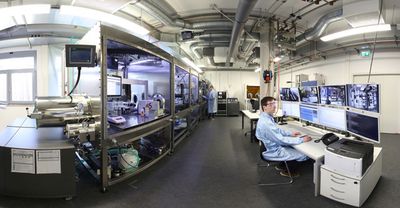Research team develops design for ultra long-life perovskite solar cells
Protective packaging for charge carriers
A research group at FAU and the Helmholtz Institute Erlangen-Nürnberg for Renewable Energy (HI ERN) have come up with a design aimed at significantly increasing the operational stability and life span of perovskite solar cells. Their design centres around a bilayer of polymers that protects the perovskites from corrosion at the same time as allowing unhindered charge transfer. The researchers’ findings have been published in the journal ‘Nature Energy’.
In the search for a more efficient way of using solar energy, efforts are under way across the globe to find alternatives to the commonly used silicon technology. Perovskite solar cells seem promising. Perovskites are a group of metal oxides that can have a wide range of different structures. What they have in common is their excellent optoelectronic performance capacity and their crystalline structure that is technologically straightforward to produce and modify.
‘The major advantage over silicone is that ultrathin layers of perovskites can be sprayed or printed onto substrates at room temperature,’ explains Prof. Dr. Christoph J. Brabec, Chair of Materials Science (Materials in Electronics and Energy Technology) at FAU, Director of Forschungszentrum Jülich and head of the research group focussing on high-throughput methods in photovoltaics at HI ERN. ‘This allows solar modules to be produced flexibly and cheaply.’
Until now, however, two major disadvantages have become apparent with the new modules. Firstly, they do not have a particularly long life span, as perovskites tend to corrode on their interfaces and their performance capacity sinks rapidly, sometimes within days. Secondly, perovskite modules are not particularly robust in elevated temperatures, which severely limits their stability in practical use scenarios. This is mainly down to the layers doped with ions that are required for transporting the charge carriers but that can also lead to undesired secondary reactions.
Double polymer layer acts as a conductor and a protective film
The high-throughput group at HI ERN has now come up with a design that eliminates the disadvantages of perovskite cells outlined above. Their design centres around a polymer bilayer that is placed directly on the perovskite. The upper layer is doped with a non-ionic acid, whilst the lower layer remains dopant free and acts simultaneously to transfer the charge and to provide protection against corrosion.
‘This architecture helps protect the extremely sensitive perovskite interface, whilst at the same time demonstrating an extraordinarily high conductivity, even at elevated temperatures,’ according to Dr. Yicheng Zhao, who has made a major contribution to developing the new module.
The results indicated stability and lifespan the likes of which have not yet been attained for perovskite solar cells. The Erlangen-based group of researchers operated the module for a total of 1400 hours at a temperature of 65° Celsius under an artificial sun, without observing any corrosion or reduction in performance.
Even after this long period of time lasting just short of 60 days, the solar cells in question still reached, on average, 99 percent of their peak efficiency. Zhao estimates that ‘under everyday conditions, it could be possible to reach up to 20,000 operating hours.’ ‘If so, the double layer structure could play a key role in the development of competitive planar perovskite solar cells.’
Automated research into high-throughput methods
The success of Christoph Brabec’s working group is based on a unique strategy i.e. research into high-throughput methods. The idea behind the concept is to automate the combined use of materials, processes and technologies and link them to methods from AI and big data. A total of 160 different types of perovskites were investigated in the described project alone. Together with other conductive and contact layers and doping alternatives, this can easily lead to several thousand combinations. Brabec: ‘Such a huge spectrum can only be tackled by carrying out parallel research into whole classes of materials, the traditional methods of investigating and optimising individual materials sequentially are simply not suitable in this context. Our approach has made our research institute one of the world leaders in the field of photovoltaics today.’
Further information
Original publication: A bilayer conducting polymer structure for planar perovskite solar cells with over 1,400 hours operational stability at elevated temperatures
DOI: 10.1038/s41560-021-00953-z
Prof. Dr. Christoph J. Brabec
Institute of Materials Science (Materials in Electronics and Energy Technology)
Phone: +49 9131 85 25426
christoph.brabec@fau.de
